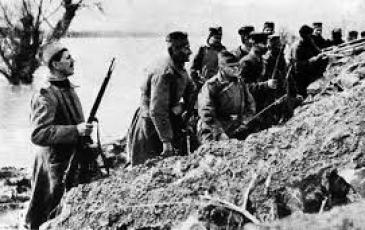1915_1029_01: The Looming Disaster - FWWC 03 Serbia '14

 0 - 0 - 2
0 - 0 - 2

| Rating: | 6.67 (3) |
| Games Played: | 2 |
| SM: | 4 |
| Turns: | 46 |
| Type: | Stock |
| First Side: | Central Powers |
| Second Side: | Allied Powers |
Kragujevac, Serbia, 29th October 1915:
Near the end of October, although Serbia was under attack from three fronts the situation had not yet become dire. About 35,000 French and 15,000 British were slowly advancing into Macedonia from the south, and the Serbians were skillfully containing the Central Powers advance at key locations.
On October 23rd, with their bridgeheads finally linked, the Germans and Austro-Hungarians begin pressing forward aggressively south of Beograd. By the 25th they had pressed back the Serbian Northern Front to Arandjelovac and Palanka, which saw heavy fighting over the next several days. This fighting began the first encirclement attempt, where von Mackensen's intended to force a decisive battle against the Serbians. The advance intended to capture Kragujevac as quickly as possible, knowing the Serbians would fight bitterly to hold their main arsenal. Once the Serbians were fully committed to battle, von Mackensen hoped to draw them into a grand encirclement carried out by the Bulgarian 1st Army advancing from the east and the Bulgarian 2nd Army moving into Macedonia to the south, with Austro-Hungarian forces moving round the flank to the west. It was estimated that a direct attack on Kragujevac, Serbia's main arsenal, would tie down the defenders while the encirclement took shape. Alternatively a devastating attack on Kragujevac might also smash through and split the Serbians into two pockets consisting of the Northern Front and Eastern Front. In the case of the latter possibility, driving a wedge down the center of the Northern Front would easily allow the Germans to get behind and cut off the Serbian Eastern Front who were desperately fighting the Bulgarians to the east.
On the 28th of October, the Serbian Northern Front took up positions around Kragujevac as predicted. Putnik decided that the Serbian Northern Front had to make a stand long enough to allow the Eastern Front (opposite the Bulgarians) sufficient time to safely link up with the rest of the army, and to prevent them from being cut off. It looked as though the Serbians were falling into the trap, and their situation was growing precarious, vulnerable from either being split in two, or flanked from the west.
Thus the battle around Kragujevac commenced, and the Serbians were forced to give battle, if only to delay as long as possible without being destroyed in the process.
[Size: medium]
*See the notes document for information on scenario design decisions and historical notes.
Near the end of October, although Serbia was under attack from three fronts the situation had not yet become dire. About 35,000 French and 15,000 British were slowly advancing into Macedonia from the south, and the Serbians were skillfully containing the Central Powers advance at key locations.
On October 23rd, with their bridgeheads finally linked, the Germans and Austro-Hungarians begin pressing forward aggressively south of Beograd. By the 25th they had pressed back the Serbian Northern Front to Arandjelovac and Palanka, which saw heavy fighting over the next several days. This fighting began the first encirclement attempt, where von Mackensen's intended to force a decisive battle against the Serbians. The advance intended to capture Kragujevac as quickly as possible, knowing the Serbians would fight bitterly to hold their main arsenal. Once the Serbians were fully committed to battle, von Mackensen hoped to draw them into a grand encirclement carried out by the Bulgarian 1st Army advancing from the east and the Bulgarian 2nd Army moving into Macedonia to the south, with Austro-Hungarian forces moving round the flank to the west. It was estimated that a direct attack on Kragujevac, Serbia's main arsenal, would tie down the defenders while the encirclement took shape. Alternatively a devastating attack on Kragujevac might also smash through and split the Serbians into two pockets consisting of the Northern Front and Eastern Front. In the case of the latter possibility, driving a wedge down the center of the Northern Front would easily allow the Germans to get behind and cut off the Serbian Eastern Front who were desperately fighting the Bulgarians to the east.
On the 28th of October, the Serbian Northern Front took up positions around Kragujevac as predicted. Putnik decided that the Serbian Northern Front had to make a stand long enough to allow the Eastern Front (opposite the Bulgarians) sufficient time to safely link up with the rest of the army, and to prevent them from being cut off. It looked as though the Serbians were falling into the trap, and their situation was growing precarious, vulnerable from either being split in two, or flanked from the west.
Thus the battle around Kragujevac commenced, and the Serbians were forced to give battle, if only to delay as long as possible without being destroyed in the process.
[Size: medium]
*See the notes document for information on scenario design decisions and historical notes.
| Gaming Records | |||||||||
|---|---|---|---|---|---|---|---|---|---|
| 1st Side Player | 2nd Side Player | Result | Score | ||||||
 |
vLuttwitz | vs. | vendetta |  |
Allied Powers Major Victory | 72 | 8 | ||
 |
PK Powers | vs. | Shackelton B |  |
Allied Powers Major Victory | 72 | 8 | ||
Serbian units have large firepower
I feel that my opponent knew what he was doing, as I kept running into his great defenses. I need to study more on command control in my WW1 battles.























